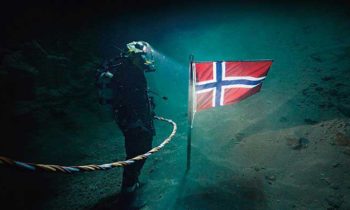 ‘Pioneer,’ from Norwegian director Erik Skjoldbjærg, tells such a complex and convoluted story, you’d think it had to be adhering to true-life events. In reality, the film is “loosely based” on events in the early 1980s in the North Sea, when Norway had just discovered the possibility of harvesting rich deposits of petroleum deep in the seabed. Given the lack of engineering technology available even thirty years ago, this task represented an enormous challenge and a significant danger to the participants.Though the country has a rich history of daring exploration and pioneering, (see: Roald Amundsen and his team’s incredible Antarctic exploration that made them the first to reach the South Pole) they would require the help of an American company, called Deep Sea Diving in the film, to help prepare them for the project. And in a shocking twist of events, the greedy Americans might not have the best interests of the Norwegian divers at heart.
‘Pioneer,’ from Norwegian director Erik Skjoldbjærg, tells such a complex and convoluted story, you’d think it had to be adhering to true-life events. In reality, the film is “loosely based” on events in the early 1980s in the North Sea, when Norway had just discovered the possibility of harvesting rich deposits of petroleum deep in the seabed. Given the lack of engineering technology available even thirty years ago, this task represented an enormous challenge and a significant danger to the participants.Though the country has a rich history of daring exploration and pioneering, (see: Roald Amundsen and his team’s incredible Antarctic exploration that made them the first to reach the South Pole) they would require the help of an American company, called Deep Sea Diving in the film, to help prepare them for the project. And in a shocking twist of events, the greedy Americans might not have the best interests of the Norwegian divers at heart.
Aksel Hennie (‘Headhunters’) plays Petter, an experienced Norwegian commercial diver who, along with his brother Knut (André Eriksen), joins the crew to prepare for the deepest dives in Norwegian history. They are accompanied by the American crew made up of fellow diver Mike, played by ‘The Hunger Games’ Wes Bentley, crew chief Ferris (Stephen Lang of ‘Avatar’), and physician/scientist Ronald, played by Jonathan LaPaglia, who is responsible for the experimental gas mixture that allows the divers to survive at depths of 300 to 500 meters. Thought it may be set at the beginning of the 1980s, ‘Pioneer’ is a ‘70s conspiracy thriller through and through, clearly and confidently an homage to films like ‘Three Days of the Condor’ and ‘The Parallax View’ that writer-director Skjoldbjærg must have grown up on. And as such, it pits the protagonist in Hennie against shadowy opponents all around, strung up by corporate interests and political ambition. Thankfully, Hennie, who proved himself more than capable of carrying a film on his own for stretches of time in ‘Headhunters’ (an excellent thriller that became the highest-grossing Norwegian film of all time, and whose producers joined on for ‘Pioneer’) is a charismatic center, bringing the requisite daring and emotional investment to the character.
The first act of the film is relatively straightforward and engaging — narrative setup showing our divers in the early stages, followed by the precipitating event, the accidental death of one of the divers. And as prescribed, this is when things go haywire. Petter emerges from the depths seething, demanding to know what went wrong. But because of the dangers of decompression sickness, he must wait two weeks before he can even exit the pressure chamber. It’s a fascinating moment in the story, and one that seems woefully underused. ‘Pioneer’ spends a good deal of time focused on the effects of deep sea pressure on the human body, but often fails to explore the effects on the psyche. Having spent two weeks trapped in a tiny, pressurized compartment under careful monitor, in what is essentially a state of shellshock, Petter emerges a man on a mission, determined to put the main plot in motion.
It’s hard to pinpoint where exactly the story loses its way. As a conspiracy surrounding a complicated experimental government project with untold millions of dollars at stake, the plot is necessarily complex. Allegiances and betrayals seem to be proliferating at an obscene rate at the peripheries of our story, and at no point is it really clear what any of the ancillary characters are after, apart from a piece of the pie. Perhaps this is the bluntness of Skjoldbjærg’s version of events, but if so, it makes for a rather unsatisfying thriller. Petter is the only character with any distinct motivation, and fortunately his emotional through line is what keeps things from spiraling too far out of control. Having boldly made a name for himself internationally in 1997 with his debut, ‘Insomnia’ (which inspired the 2002 remake from Christopher Nolan), it’s no wonder Skjoldbjærg chose this story. The deep sea sequences are beautifully shot by cinematographer Jallo Faber, and the director certainly nails the ‘70s aesthetic on the head. But with such compelling subject material, it’s a shame the film can’t quite find its way.
(bestmoviesevernews)
